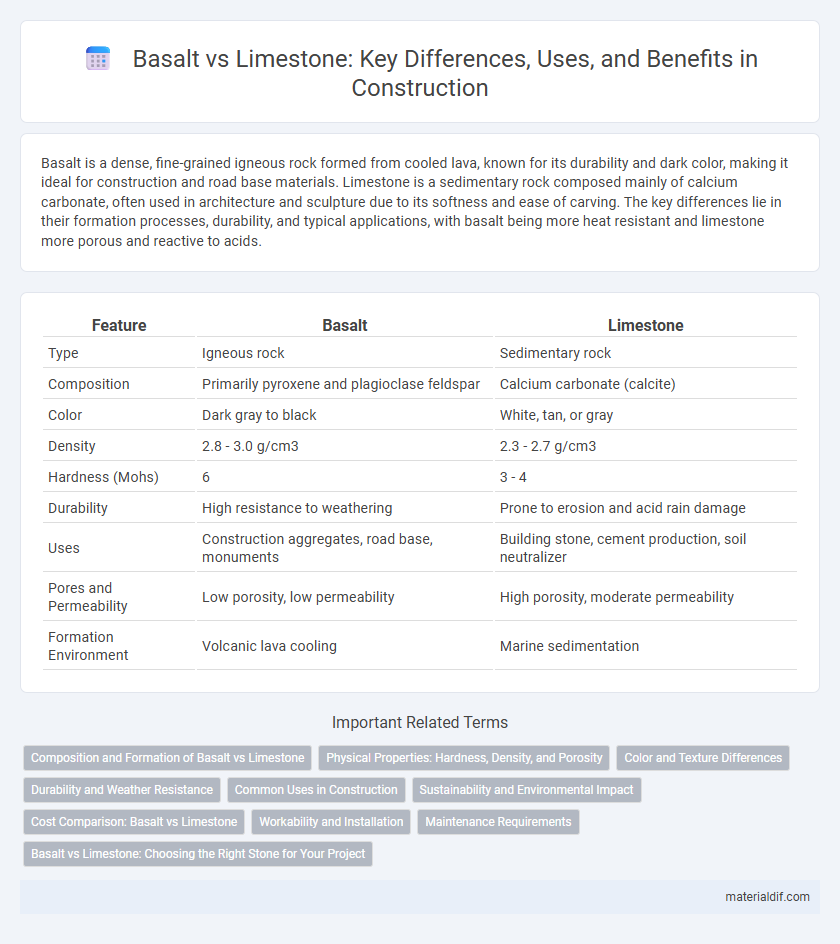Basalt is a dense, fine-grained igneous rock formed from cooled lava, known for its durability and dark color, making it ideal for construction and road base materials. Limestone is a sedimentary rock composed mainly of calcium carbonate, often used in architecture and sculpture due to its softness and ease of carving. The key differences lie in their formation processes, durability, and typical applications, with basalt being more heat resistant and limestone more porous and reactive to acids.
Table of Comparison
| Feature | Basalt | Limestone |
|---|---|---|
| Type | Igneous rock | Sedimentary rock |
| Composition | Primarily pyroxene and plagioclase feldspar | Calcium carbonate (calcite) |
| Color | Dark gray to black | White, tan, or gray |
| Density | 2.8 - 3.0 g/cm3 | 2.3 - 2.7 g/cm3 |
| Hardness (Mohs) | 6 | 3 - 4 |
| Durability | High resistance to weathering | Prone to erosion and acid rain damage |
| Uses | Construction aggregates, road base, monuments | Building stone, cement production, soil neutralizer |
| Pores and Permeability | Low porosity, low permeability | High porosity, moderate permeability |
| Formation Environment | Volcanic lava cooling | Marine sedimentation |
Composition and Formation of Basalt vs Limestone
Basalt is an igneous rock primarily composed of plagioclase, pyroxene, and olivine minerals, formed from the rapid cooling of basaltic lava at the Earth's surface. Limestone consists mainly of calcium carbonate, often derived from accumulated marine organisms' skeletal fragments and precipitated chemically in shallow, warm marine environments. The formation of basalt involves volcanic activity and solidification of molten magma, while limestone forms through sedimentary processes over geological time.
Physical Properties: Hardness, Density, and Porosity
Basalt exhibits a higher hardness rating of 6 on the Mohs scale compared to limestone's softer range of 3 to 4, making basalt more resistant to scratching and wear. The density of basalt typically ranges between 2.8 to 3.0 g/cm3, significantly greater than limestone's density of approximately 2.3 to 2.7 g/cm3, indicating basalt's greater mass per unit volume. Limestone usually has higher porosity, varying from 5 to 30%, allowing for more water absorption, whereas basalt's porosity is generally below 5%, resulting in better durability and lower permeability.
Color and Texture Differences
Basalt typically exhibits a dark gray to black color with a fine-grained, dense texture formed from rapid cooling of lava, making it hard and durable. Limestone, in contrast, ranges from white to light gray, beige, or even soft yellow, featuring a coarse or smooth texture composed mainly of calcite and often containing visible fossils or shell fragments. These distinct color and texture differences influence their application in construction and decorative uses, with basalt favored for heavy-duty structural elements and limestone prized for ornamental facades and interior finishes.
Durability and Weather Resistance
Basalt exhibits superior durability and weather resistance compared to limestone due to its dense, fine-grained volcanic origin, making it highly resistant to abrasion, chemical weathering, and freeze-thaw cycles. Limestone, primarily composed of calcium carbonate, is more susceptible to acid rain and erosion, which can compromise its structural integrity over time. This makes basalt particularly well-suited for high-traffic pavements and outdoor architectural elements in harsh climates.
Common Uses in Construction
Basalt is widely used in construction for its durability and strength, making it ideal for road bases, building blocks, and decorative aggregates. Limestone is prized for its versatility, commonly utilized in cement production, as dimension stone, and in the creation of facade cladding and flooring tiles. Both stones contribute essential structural and aesthetic qualities to modern construction projects.
Sustainability and Environmental Impact
Basalt is a highly sustainable stone due to its abundant natural availability and minimal processing requirements, resulting in low carbon emissions during extraction and production. Limestone, while also widely available, often undergoes intensive quarrying and chemical processing that release notable amounts of CO2, contributing to environmental degradation. The dense, durable nature of basalt promotes long-term use with minimal maintenance, enhancing its overall environmental benefits compared to the more porous and weather-sensitive limestone.
Cost Comparison: Basalt vs Limestone
Basalt generally costs more than limestone due to its higher density and durability, making it ideal for heavy construction projects. Limestone is often less expensive, offering a cost-effective choice for landscaping and decorative uses. Pricing varies regionally but basalt's superior strength typically results in a higher initial investment compared to limestone.
Workability and Installation
Basalt offers superior durability and requires specialized cutting tools due to its hardness, making installation more labor-intensive compared to limestone. Limestone is softer and easier to shape, allowing for faster workability and simpler installation processes, especially in intricate designs. The choice between basalt and limestone often depends on project requirements for strength versus ease of handling during construction.
Maintenance Requirements
Basalt requires minimal maintenance due to its high durability and resistance to weathering, making it ideal for outdoor applications. Limestone demands more frequent upkeep, including sealing and cleaning, to prevent staining and erosion because of its porous nature. The choice between basalt and limestone significantly impacts long-term maintenance costs and efforts.
Basalt vs Limestone: Choosing the Right Stone for Your Project
Basalt offers exceptional durability and resistance to weathering, making it ideal for outdoor projects requiring long-lasting strength. Limestone features a softer texture and natural aesthetic, preferred for decorative applications and indoor use where ease of carving and shaping is important. Selecting between basalt and limestone depends on project requirements such as durability, finish, and environmental exposure.
Basalt vs Limestone Infographic

 materialdif.com
materialdif.com